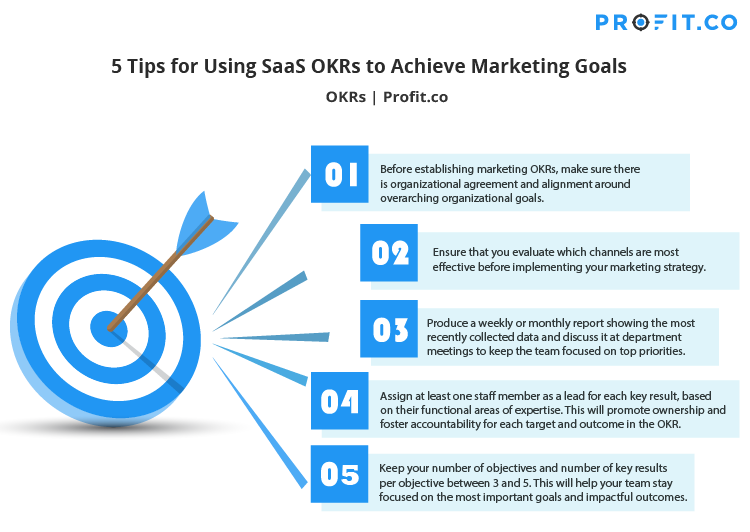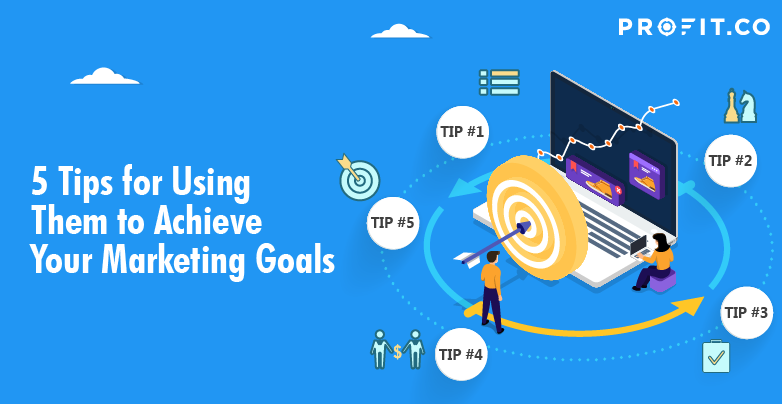“Measuring busy-ness is far easier than measuring business.” This quote, by noted entrepreneur and best-selling author, Seth Godin, underscores the importance of establishing the right SaaS OKRs to evaluate the success of your marketing efforts.
OKRs, or, Objectives and Key Results, are tangible goals and measurements which can be used to focus your marketing strategies. OKRs help individuals, teams, departments, and organizations as a whole determine whether their efforts are having a positive and substantial impact on their company’s bottom line, and can encourage more effective strategy execution.
Many marketing departments use OKRs to help define their most important goals. While some marketing OKRs may have relevance across multiple industries, others are unique to organizations in the Software as a Service (SaaS) space. In this article, we highlight SaaS-specific OKRs and offer guidance on using them to achieve your SaaS marketing goals.
Measuring busy-ness is far easier than measuring business.
The One Big Goal for SaaS Organizations
For most SaaS startups, the primary goal is to increase Monthly Recurring Revenue (MMR), which is the regular subscription revenue collected from clients each month. MMR is considered the amount of predictable revenue a business can expect, and it forms the basis of profitability for subscription-based companies.
Be aware that once in a while there may be a strategic shift in focus for SaaS entities. For example, a company may decide to take a year to vastly improve their UX design, add new features, or acquire and integrate other software into the platform.
Assuming driving MMR growth is one of the primary goals, you should then consider what the primary goals of the marketing department are.
Tip #1: Before establishing marketing OKRs, make sure there is organizational agreement and alignment around overarching organizational goals.
Primary Goals for SaaS Marketing Departments
At the highest level, most SaaS marketing departments focus on five broad categories of goals. The goals themselves don’t change much from year to year, but the objectives – strategic activities and tools to measure their success – do vary. The five general goals SaaS Marketing Departments have are:
- Generate New Leads
- Convert Leads to Paying Customers
- Increase Average Revenue Per Customer
- Retain Existing Customers
- Achieve All of the Above as Quickly, Efficiently and Cost-Effectively as Possible*
*Inherent in nearly any goal are the elements of time and expense. Because time is money, the quicker you can convert a lead to a customer, for example, the more time you have freed up to generate additional leads or customers. Likewise, if you can decrease the total cost of acquiring a customer from $550 to $420, you’ve just contributed to the larger MMR goal by reducing costs a full $130 per client.
If you are new to the concept of setting objectives and identifying measurable outcomes to track your results, these broad goals are a valuable place to begin defining OKRs. Here are a few of the most popular key performance indicators, or measurements, for effectively tracking marketing outcomes:
- Cost Per Lead (CPL) – How much does it cost, on average, to generate one new lead? CPL = Total Marketing Spend / Total New Leads
- Cost of Acquisition (COA) – How much does it cost, on average, to generate one paying customer? COA = Total Sales & Marketing Spend / Total New Customers
- Average Revenue Per User (ARPU) – How much revenue are we getting, on average, per user or per subscriber each year? ARPU = Total Revenue / Average Users During a Period
- Churn Rate – The rate at which subscribers cancel or don’t renew, also called attrition.
- Customer Lifetime Value (CLV) – How much will the customer spend from the time of acquisition until the relationship ends?
Setting Targeted Marketing OKRs
Since the overarching marketing goals above don’t usually vary much from year to year, with each new planning cycle teams must decide where to focus the department’s energy and budget to have the greatest impact. These strategic choices will guide which OKRs a marketing team will choose.
Example: Cost Per Lead by Channel
Virtually every SaaS business needs a steady stream of new prospects to remain profitable. These leads come from many channels, including organic keyword searches, social media, content-based marketing, word-of-mouth referrals, trade shows, advertising and email campaigns.
An upscale marketing program will set objectives for each lead channel. Those objectives will be tied to a designated budget, specific strategies and tracking tools that are regularly monitored through OKR software or some other tracking methodology. Over time this “leads by channel” data helps your marketing department identify which marketing strategies are producing real results and which ones are falling flat.
Tip #2: Ensure that you evaluate which channels are most effective before implementing your marketing strategy.
For instance, by tracking Cost Per Lead Per Channel carefully, you learn it costs $200 to gain a lead through online display advertising and that leads from this channel convert to customers at a rate of 20%. You also learn that it only costs $35 per lead through social media, but only .025% of them convert. Using a hypothetical $10,000 budget for each strategy, you discover you can expect to acquire 10 paying customers through online advertising and just 7 from social media.
 Objective
Objective
Decrease Cost Per Lead (CPL) Via SEM/Organic Search Channel
Target Date: Annual-2021
Visibility: All Employees
 Key Results
Key Results
Increase conversion rate from 5% to 9% by conducting A/B test for Landing pages
Post at least 2 SEO-rich posts per month.
Increase organic web traffic from 2000 to 3200 visitors per month as measured by Google Analytics.

Decrease CPL in SEM/Organic Search from $275 to $195.

Armed with this trackable data, you can make more-informed decisions about where to invest your marketing resources in the future. In doing so, you’ll begin to recognize that some leads are more desirable than others.
Tip #3: Produce a weekly or monthly report showing the most recently collected data and discuss it at department meetings. This will help keep the team focused on the top priorities and stimulate conversations about strategy.

Example: Shorten Lead to Sales Conversion Timeline
Let’s say your department is great at attracting new leads, but it takes an average of six months for prospects to sign a contract to become a customer. Both the marketing and sales departments agree that the sales cycle could be shortened if prospects could better understand how the features of the software can make their jobs easier.
To address this issue, you decide to create a new suite of content targeted to new leads via an automated email campaign. The content will include white papers, video clips, client case studies, a free webinar demo, and an interactive tool to guide new users through the software.
 Objective
Objective
Shorten Lead-to-Sale Closing Cycle
Target Date: Annual-2021
Visibility: All Employees
 Key Results
Key Results
Develop 5 new marketing content targeted to new leads (Increase KPI)
Maintain an average email open rate of at least 35%
Maintain at least 20% of leads in attendance at demo webinars

Shorten Lead-to-Sale Cycle from 180 Days to 90 Days as measured by CRM

Tip #4: Assign at least one staff member as a lead for each key result, based on their functional areas of expertise. This will promote ownership and foster accountability for each target and outcome in the OKR.
Other OKRs Examples
Depending how granular you decide to get, there are literally hundreds of possible OKRs that SaaS marketing departments can define and track. It’s important to learn from your OKRs each quarter, and iterate your targets so that you are setting and achieving the most impactful goals for your team, department, or company.
For instance, it is far less expensive to retain an existing client than to land a new one. Discovering the factors that drive retention and developing OKRs around them will help keep churn rates in check.
Here are a few more key result examples to jumpstart your OKR implementation:
- Increase customer satisfaction
- Improve ad/social click through rates (CTRs)
- Improve first response times
- Increase social media engagement
- Increase ARPU by upselling products A, B, or C
- Reduce churn rate/improve customer retention
- Rank in top three of search engine pages for X key words
Tip #5: Limit the number of objectives per team, department, or OKR level between three and five. Keep the number of key results defined per objective between three and five as well. Too few, and they may appear to lack import; too many and your team may lose focus on what is most important.
The Power of SaaS OKRs
In addition to improving your SaaS organization’s bottom line, OKRs help you clearly define what “success” looks like for your marketing department and individual team members. It keeps them focused, and it allows you to track important trends over time so that you can stay ahead of the curve.
Profit.co’s agile and intuitive OKR software can help you effectively execute your marketing strategy, and is built for iteration and transparent work throughout your organization. You can try Profit.co completely free today, or schedule a personalized demo with our OKR experts!
Ready to start your OKR Journey for FREE?

